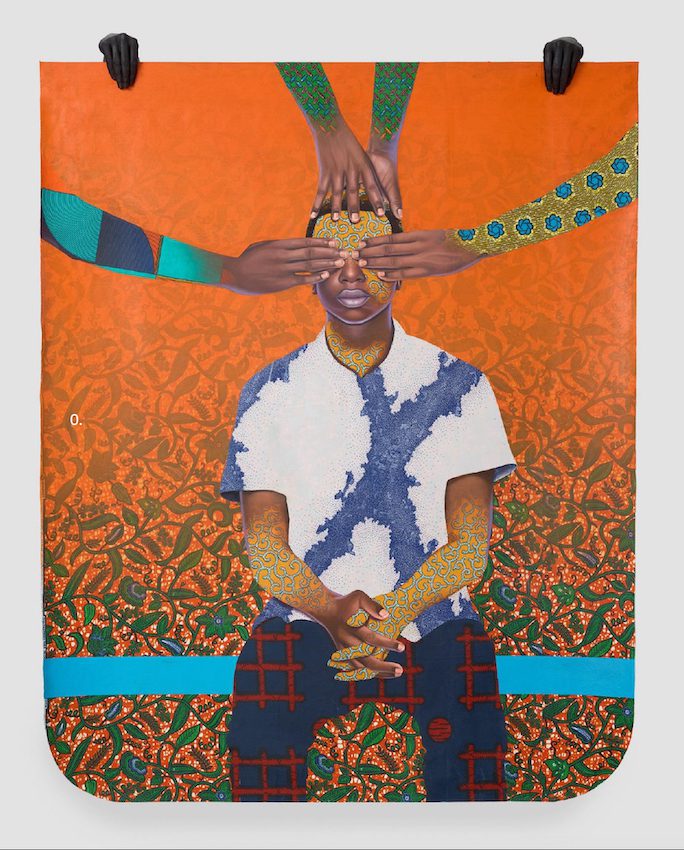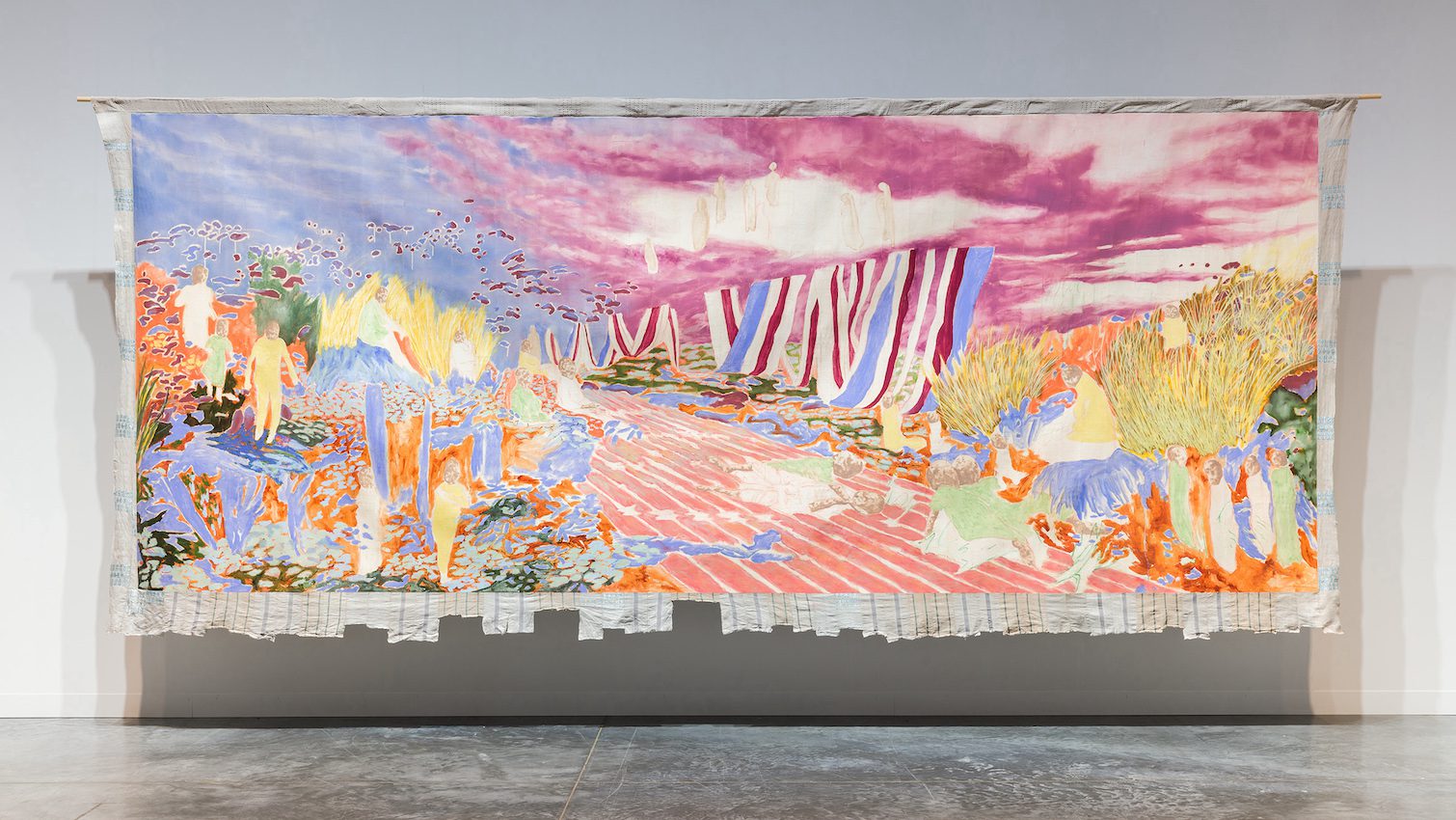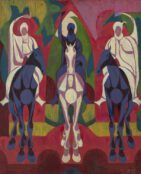Mar 16 - Apr 29
10:00 - 17:00
Location
Gagosian London
For art readers of a particular bent the hooks of migration, van Gennep, and material symbolism are sweet candies of a tantalising flavour. There have been a number of shows covering this topic in recent months and often the shoehorning of various artists together by nationality, race or Western colonial adjunct feels vague, or worse, convenient. But here Gagosian is presenting a tighter context and if successful a deeper artistic experience. The emotional and political stakes here are high and contemporaneous, but they’re also ubiquitous, can Gagosian pull it off?

Patrick Quarm, Make you no see, 2022, © Patrick Quarm. Photo: Chris Gardner. Courtesy the artist
Exhibition Notes:
LONDON, February 13, 2023—Gagosian is pleased to present Rites of Passage at the Britannia Street gallery. Curated by Péjú Oshin, this exhibition features work by eighteen contemporary artists who share a history of migration.
Rites of Passage explores the idea of “liminal space,” a coinage of anthropologist Arnold van Gennep (1873–1957). In his 1909 book, after which the exhibition is titled, Van Gennep was among the first to observe that the transitional events of birth, puberty, marriage, and death are marked by ceremonies with a ritual function that transcends cultural boundaries. Highlighting this phenomenon in physical, mental, and spiritual arenas, Oshin’s exhibition challenges linear narratives through works in a variety of mediums, which fill Gagosian’s expansive Britannia Street gallery.

ÀSÌKÒ, Pillars at the Port, 2022. © Àsìkò. Courtesy the artist
Rites of Passage is structured in correspondence with liminality’s three stages: separation, transition, and return. Each of these phases addresses the act of movement, not only through individual experience, but also in the broader context of community. The exhibition examines the status of postcolonial Black identity, specifically the “triple consciousness” experienced by members of the African diaspora when encountering counterparts who identify with local majority populations. The artists in the exhibition are further grouped together according to themes of tradition, spirituality, and place.
Welcoming viewers to the gallery is Elsa James’s Ode to David Lammy MP (2022). The work’s black neon text reads I AM HERE BECAUSE YOU WERE THERE, a powerful affirmation of placemaking that originates in a 2018 speech made by the MP in response to the Windrush scandal, in which British subjects — many of whom had arrived in the country from Caribbean nations decades earlier — were wrongly detained or threatened with deportation. The experiences of the Windrush generation also inform the work of Enam Gbewonyo, who investigates cultural history through the manufacture and manipulation of textiles. Patrick Quarm, too, identifies significance in fabric, uncovering the cultural reflectivity that lingers within batik material despite its highly commodified status. And Adelaide Damoah, for her part, explores colonial history by transposing texts and maps onto photo collages of herself and her mother, grandmother, great-grandmother, and great-great-grandmother, thereby contesting outdated ideologies imposed on her familial narrative.
The exhibition’s spiritual theme emerges in works from Manyaku Mashilo’s Celestial Cartographies (2020–), a series of paintings in which imaginary characters move through abstracted cosmological landscapes that refer to African faiths and identities. In his tapestry, Victor Ehikhamenor stitches thousands of rosary beads to canvas and lace, cutting across history, memory, and belief to explore the role of religion and spirituality as tools for both survival and oppression. Àsìkò, in his photographs, recombines and extends various masquerade traditions rooted in Yoruba history and culture to explore how the representation of ancestral communities might inflect contemporary diasporic identities, while Julianknxx’s film installation considers the integration of liminality into Krio traditions as a waypoint between and construction of both local and global perspectives.

Nengi Omuku, Eden, 2022. © Nengi Omuku 2023. Photo: Mark Blower. Courtesy the artist and Pippy Houldsworth Gallery, London
Finally, in the works of many artists in the exhibition, such ideas intersect with perspectives on the complex and consistent influence of place. Phoebe Boswell considers bodies of water as repositories of both painful historical experience and hope for the future—natural loci of healing, reclamation, and possibility—while Mary Evans employs pop-cultural imagery to examine the relationship between contemporary Britain and its imperial past through the lens of her own childhood.
Featured artists: Tunji Adeniyi-Jones, Àsìkò, Phoebe Boswell, Adelaide Damoah, Femi Dawkins, Victor Ehikhamenor, Mary Evans, Ayesha Feisal, Enam Gbewonyo, Elsa James, Julianknxx, Sahara Longe, Manyaku Mashilo, Emily Moore, Nengi Omuku, Patrick Quarm, Alexandria Smith, Sharon Walters, and Michaela Yearwood-Dan

Elsa James, Ode to David Lammy MP, 2022.
© Elsa James. Photo: Anna Lukala. Courtesy the artist and Focal Point Gallery
RITES OF PASSAGE
March 16–April 29, 2023
Gagosian Gallery
6–24 Britannia Street, London















